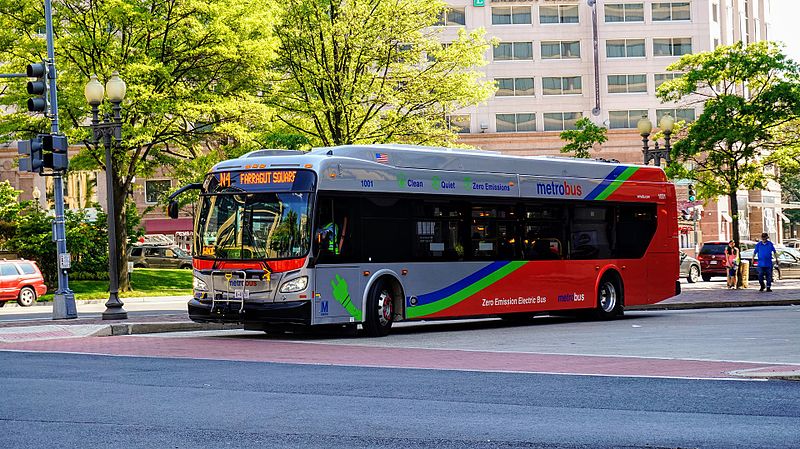More And More DC-Area Bus Systems Are Moving Toward Electric Fleets
Electric vehicles have been a vague, futuristic idea for many years now, but electric buses are starting to be introduced to more and more bus systems in the Washington, DC area. Electric buses are more energy efficient than diesel or CNG (compressed natural gas) powered buses and are an important part of rising concerns about climate change all over the world. Electric buses require serious infrastructure and are much more expensive than non-electric buses, so conversion to a fully electric fleet is a long process. In the DC area, the main bus service provider is WMATA (Washington Metropolitan Area Transit Authority) Metrobus, but there are many jurisdictional providers that have been taking over former Metrobus routes such as Fairfax Connector, Arlington Transit, DASH, DC Circulator, and Ride-on to name a few. Even bus systems that are yet to introduce electric buses to their fleets are expected to begin to do so in the near future, and many systems already have hybrid electric buses, which is an important step toward fully electric buses.
The Metrobus system sprawls all across the DC area and is the largest bus provider in the DC area. Currently, Metrobus only operates one fully electric bus, which is a New Flyer Xcelsior XE40. It has been in service for over a year now, as a sort of proof of concept. Construction is underway at a bus garage in DC that will allow for over 50 additional electric buses, which will be a big leap forward. Until then, Metrobus has ordered 2 electric articulated buses that are 2021 models. Details have not yet been released to the public. Aside form these electric buses, Metrobus operates a fleet of Diesel, Diesel-electric hybrid, and CNG buses.
Alexandria’s local bus service, DASH (Driving Alexandria Safely Home,) currently operates three fully electric buses, which are New Flyer Xcelsior CHARGE XE40s. They entered service in November 2020. DASH already has three additional electric buses on property, Proterra ZX5s, that have not yet entered service. DASH plans to operate a fully electric fleet by 2040, so it is moving forward fast with new electric buses. DASH has also already ordered eight more electric buses from New Flyer, which are 2021 models, that will bring DASH’s total up to 14 electric buses when they arrive. DASH has installed chargers at their garage, but on-the-go recharging stations are planned to be installed in various locations in the future to support the new fleet.
Montgomery County’s local bus system, Ride-on, currently has four electric buses. They are Proterra Catalyst BE35 models, and entered service in fall 2020. Ride-on is expected to purchase additional electric buses in the future as a part of Montgomery County’s climate action plan, but no plans to do so have been released to the public. The rest of Ride-on’s fleet operates on CNG or Diesel, with the exception of 53 vehicles that are Diesel-electric hybrids.
DC circulator, which provides service through important points in Washington, DC, has 14 electric buses in its fleet. They are Proterra Catalyst BE40 E2 models, which have been in service since mid 2018. This is especially impressive because these electric buses make up 19% of the DC circulator fleet. No plans for any further buses have been released to the public, but when DC circulator purchases new buses it is likely that they will purchase additional electric vehicles. DC circulator’s other fleet consists of Diesel and Diesel-electric hybrid buses.
Electric buses are certainly good for reducing emissions, but there is more to consider. Electricity in the DC area mostly comes from the burning of various fossil fuels, so electricity sources have to be monitored and made sure that electricity comes from non-polluting sources. Another important point is that in the US, most vehicular traffic consists of private automobiles. It is crucial that private vehicles also run on electricity. Electric buses are almost twice the price of diesel or CNG buses and require a lot of expensive equipment to be charged, so transit agencies are often reluctant to begin converting to an electric fleet. Agencies like CUE, Arlington Transit, and Fairfax Connector have experimented with hybrid-electric buses, and are likely to follow other agencies and move toward electric buses in the future. The process of electrifying bus service has begun in the DC area, and in twenty years it could well be that it is rarer to see a non-electric bus than and electric one in service.
Related articles and information:
https://www.dccirculator.com/meet-the-fleet/
https://lims.dccouncil.us/Legislation/CA22-0144?FromSearchResults=true















